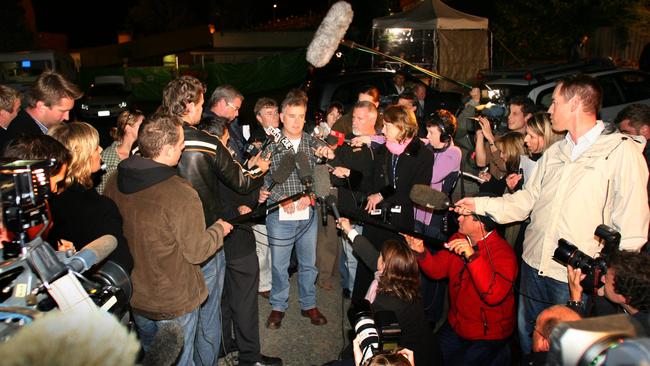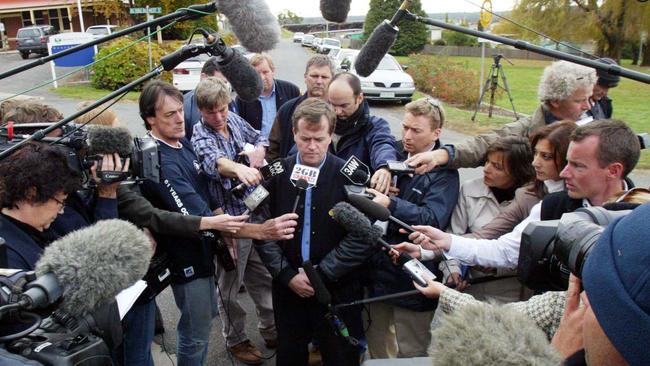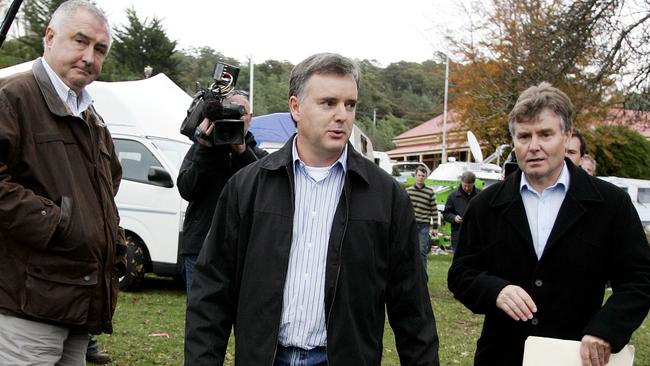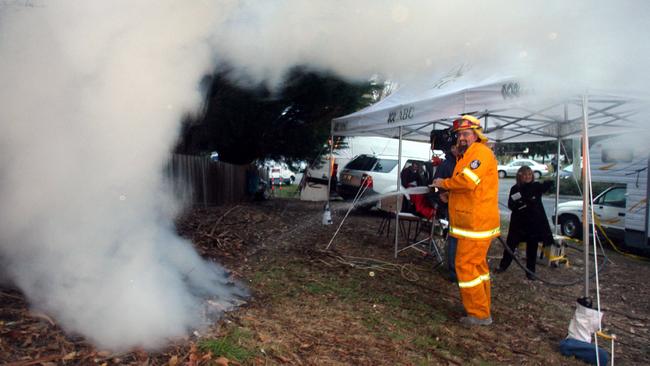Talking Point: The whole world is watching
MIKE LESTER: There was mayhem surrounding the miraculous survival of two Tasmanian miners at Beaconsfield.

Opinion
Don't miss out on the headlines from Opinion. Followed categories will be added to My News.
ON the chilly morning of May 9, 2006, I was standing on the hill outside Beaconsfield Gold Mine’s metal-walled Emergency Operations Control Room overlooking the mine shaft head.
I was working as public relations consultant for the mine and we had just sent out an SMS text message saying Todd Russell and Brant Webb were finally free.
Lights were flickering on across the media’s Winnebago and tent city in the carpark outside the mine’s gates and people were running around frantically setting up.
It was like someone had poked a stick in an ant nest.
Inside the mine there was an air of excitement, tempered with nervousness. What if, despite the planning and preparations, something went wrong with the world’s media watching?
Everyone knows the story.
At 9.23pm on Anzac Day 2006, 17 men were working underground at the gold mine, having started their shift a few hours earlier. Two of this crew, Todd Russell and Brant Webb, were in a tunnel 925m below ground, referred to as the 925 metre level (925mL), working out of a basket, while a third, Larry Knight, operated a forklift cherry-picker machine called a telehandler that held them there.
A seismic event, later measured as 2.3 on the Richter scale, occurred about 40m from where the three were working. It was akin to a mini earthquake. It shook the underground workings and caused the rock that formed the tunnel to collapse on top of the three men.
Within a short time, a rescue team was sent in. It takes less than two minutes to descend the shaft in the cage from the surface to the 375 level. From there, it’s a 4.4km drive down a spiralling corkscrew tunnel to reach the 925 level. Rescuers found a nightmare landscape: a rock fall as high as the roof, 4m up. Looking down from the level above there were gaping holes.

The first media call was received at 2.20am on April 26 and the first of 24 media releases to be issued by the mine over the next 14 days was distributed just after 3.30am.
In a few short days the park and carpark became Winnebago City. Outdoor broadcast vans, their satellite dishes pointed to the heavens, emblazoned with Nine, Seven, Ten and the ABC seemed to be everywhere. Over the next 14 days it seemed everybody who was anybody in Australian media had arrived on their doorstep — Kochie and Mel, Karl Stefanovic, Naomi Robson, Tracy Grimshaw, Richard Carleton, a multitude of print reporters, and overseas outfits like CNN.
At the height of the rescue we were getting calls around the clock for updates, including from the BBC and CNN, and requests for interviews from household names like United States TV personality Oprah Winfrey.
From the start there was a lot more media interest than you might expect for a rock fall in a Tasmanian mine, even if three miners were missing.

A lot of media with outdoor broadcast equipment and crews were already on their way to Tasmania from interstate for the tenth anniversary of the Port Arthur massacre that week. Some media cars in the carpark outside the mine gates were there for Targa Tasmania.
At the peak of the rescue, not a room was available in a hotel, motel or bed and breakfast in Beaconsfield or any town within half an hour’s drive, making it difficult to house rescuers who turned up to help.
On the morning of April 27, the media were baying for an update for their breakfast news shows and we had scheduled a media conference for 7am. Just before he was due to go out and face the pack, mine manager Matt Gill got a call from underground. They had found a body.
We had to delay the media conference to wait for details, then alert the police and coroner and tell the families. Once that was done Matt fronted the media informing them a body had been found and they had grave concerns for the other two men. This was extremely difficult for Matt. His voice quavered. He almost cried.
With discovery of Larry Knight’s body, a pall of gloom descended over the town and it affected the media too. Most media now believed all three miners had been killed.
On April 28, we informed the media that work had started on a 36m-long tunnel that involved drilling, blasting, bolting and strapping, and that this would necessarily take time. As a result, some media packed up to go home or to Port Arthur after their vigil.
We held a press conference at 12.30pm on Sunday to report on progress. The media had an appetite for minute detail. They wanted to know about the drilling and blasting process and why it was taking so long. Matt told them they had blasted about 17.5m, about half the distance required, and that the tunnel was about 4.2m wide and 4.5m high. They had removed 780 tonnes of rock since Friday and each firing required 50 blast holes to be drilled and fired to achieve about 3.5m of distance. He could not say when they would reach where Todd and Brant were last seen.

Then, as everyone now knows, about 5.40pm on the Sunday, nearly five days after the Anzac Day tremor, Matt got a call in the control room from underground mine manager Pat Ball who was supervising the search and rescue. Pat passed on the startling news that he and Steve “Salty” Saltmarsh had got within 4m of the telehandler, and called out asking whether anyone was there — and heard back two distinct voices.
The next two hours were frenetic at the mine. People were numb, but excited.
A brief statement went out by email to media outlets at 7.35pm and was hand delivered to those outside the mine gates. It read:
“A short time ago rescuers at the Beaconsfield Mine believe they have located the two miners missing since last Tuesday night. Indications are that the two men are still alive”.
With that brief statement Beaconsfield took a giant leap from being a mine accident and rescue story to one of human courage and survival; a story of death and life.
Over the following days the rescue was a rollercoaster of highs and lows. On one black day, Pat Ball felt it was time for a pep-talk for the small group crowded in the rescue operations room: “Listen, there have already been four miracles here. The first that they were in the cage when the rock fall occurred; the second that the cage held; the third that the hanging wall rock held and it was a fourth miracle that Salty and I just happened to go into 925 when we did and call to them and hear them respond. We’re going to get them out”.
Overall the media were well behaved, but the rescuers intensely disliked them. They perceived them as rude and ghoulish. There were instances where rescuers had gone home to snatch a few hours’ sleep only to be woken by maverick journalists knocking on their doors. Someone in the media got the emergency control room number and swamped it with calls, forcing the mine to change numbers.
In retaliation, someone lit a fire in the media tent city. There were threats journalists would be beaten up in pubs.

One of the worst aspects was the helicopters. There were three, sometimes four, flying over the site, three or four times a day. All the buildings on the site are metal — metal walls and roofs, and low ceilings — and when the choppers were up it was impossible to hear each other.
As part of the planning for when Todd and Brant were brought to the surface it was agreed a television camera, a newspaper photographer and a radio commentator could take a position in the viewing platform of the mine museum directly overlooking the mine shaft.
They would get a perfect view of Todd and Brant emerging, be close to the action, but also out of the way.
In the end it did not matter because Todd and Brant walked out and the tarps came down, everyone got their shots, and the world marvelled at their miraculous survival.
Michael Lester is a Tasmanian public relations consultant and former political reporter for the Mercury. In 2006 he was engaged as PR adviser for the Beaconsfield Gold Mine.


